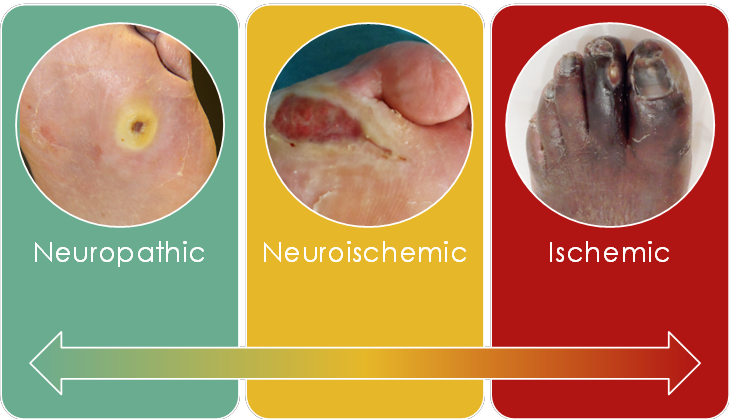Deciphering Diabetic Foot: Understanding Neuropathic and Neuroischemic Conditions
When it comes to diabetic foot complications, they typically fall into two major categories: Neuropathic Foot and Neuroischemic Foot. Recognizing the differences between these two conditions is critical because they require distinct treatment strategies and can lead to diverse complications.

Neuropathic Foot: Navigating Nerve Dysfunction
In the Neuropathic Foot, nerve dysfunction takes center stage, resulting in various issues such as fissures, bullae, Charcot joints, neuropathic edema, and digital necrosis. These neuropathic alterations present unique challenges and demand tailored treatment approaches.
Neuroischemic Foot: Battling Blood Flow Blockages
In the Neuroischemic Foot, blood flow blockages due to vascular disease are paramount, although neuropathy remains a factor. Ischemia often manifests as rest pain, foot ulcers along foot margins, digital necrosis, and gangrene. Accurately distinguishing between neuropathic and ischemic components is crucial for effective management.
Thorough Examination: The Foundation of Diabetic Foot Evaluation
A comprehensive foot examination is imperative for every diabetic patient, focusing on identifying neuropathic indicators like dry skin, deformities, ulcers, and calluses. Signs of ischemia include hair loss, dependent rubor, and weakened peripheral pulses. Palpating and listening to arterial pulses provide further insights into vascular health.
Sensory Neuropathy Assessment
Evaluating sensory neuropathy involves testing protective sensations using tools like monofilaments, biothesiometry, and simple items such as cotton wool, pinpricks, and tuning forks. Detecting loss of protective sensations (LOPS) is crucial for identifying individuals at risk of developing foot ulcers.
Vascular Evaluation: Leveraging Doppler and Ankle-Brachial Index (ABI)

A handheld Doppler device confirms pulse presence and strength. Ankle-Brachial Index (ABI) measurement, comparing systolic pressures in ankle and brachial arteries, aids in evaluating vascular supply. An ABI < 0.9 indicates significant ischemia, while ABI > 1 suggests normal vascular function.
By adopting a comprehensive assessment approach and understanding the nuances between neuropathic and neuroischemic foot complications, healthcare providers can tailor interventions to reduce the risk of diabetic foot ulcers and enhance patient outcomes.
Take a look at our comprehensive collection of diabetic-friendly footwear options, tailored to address your specific needs and preferences.
Find the perfect fit from our most popular styles, conveniently available at DiabeticShoe.in








